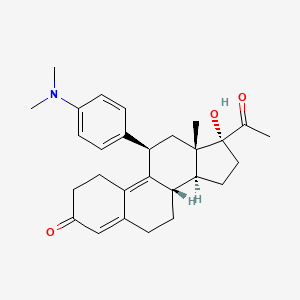



1. 17alpha-acetoxy-11beta-(4-n,n-dimethylaminophenyl)-19-norpregna-4,9-diene-3,20-dione
2. Cdb 2914
3. Cdb-2914
4. Hrp 2000
5. Hrp-2000
6. Rti-3021-012
7. Rti-3021-022
8. Va-2914
9. Va2914
1. 159811-51-5
2. Uliprisnil
3. 6j5j15q2x8
4. (8s,11r,13s,14s,17r)-17-acetyl-11-[4-(dimethylamino)phenyl]-17-hydroxy-13-methyl-1,2,6,7,8,11,12,14,15,16-decahydrocyclopenta[a]phenanthren-3-one
5. 11beta-(4-(dimethylamino)phenyl)-17-hydroxy-19-norpregna-4,9-diene-3,20-dione
6. (8s,11r,13s,14s,17r)-17-acetyl-11-(4-(dimethylamino)phenyl)-17-hydroxy-13-methyl-6,7,8,11,12,13,14,15,16,17-decahydro-1h-cyclopenta[a]phenanthren-3(2h)-one
7. Ulipristal [inn]
8. Ellae
9. Ulipristal [usan:inn:ban]
10. Unii-6j5j15q2x8
11. Ulipristal-d3
12. Pgl 4001
13. Ulipristal (usan/inn)
14. Ulipristal [usan]
15. Ulipristal [vandf]
16. Ulipristal [who-dd]
17. Ulipristal Acetate Ulipristal
18. Schembl545159
19. Ulipristal [ema Epar]
20. Chembl2103846
21. Chebi:177631
22. Dtxsid501025842
23. S3081
24. Zinc34089131
25. Akos025401807
26. Db08867
27. Ac-25786
28. Bs-15555
29. Hy-14959
30. Rti-3021-022
31. Ulipristal Acetate Ulipristal [mi]
32. Cs-0003658
33. D09567
34. H12074
35. A906751
36. Q27264992
37. 11.beta.-(4-(dimethylamino)phenyl)-17-hydroxy-19-norpregna-4,9-diene-3,20-dione
38. 17alpha-acetoxy-11beta-(4-n,n-dimethylaminophenyl)-19-norpregna-4,9-diene-3,20-dione
39. 19-norpregna-4,9-diene-3,20-dione, 11-[4-(dimethylamino)phenyl]-17-hydroxy-, (11beta)-
40. (8s,11r,13s,14s,17r)-17-acetyl-11-(4-dimethylamino-phenyl)-17-hydroxy-13-methyl-1,2,6,7,8,11,12,13,14,15,16,17-dodecahydro-cyclopenta[a]phenanthren-3-one
| Molecular Weight | 433.6 g/mol |
|---|---|
| Molecular Formula | C28H35NO3 |
| XLogP3 | 2.9 |
| Hydrogen Bond Donor Count | 1 |
| Hydrogen Bond Acceptor Count | 4 |
| Rotatable Bond Count | 3 |
| Exact Mass | 433.26169398 g/mol |
| Monoisotopic Mass | 433.26169398 g/mol |
| Topological Polar Surface Area | 57.6 Ų |
| Heavy Atom Count | 32 |
| Formal Charge | 0 |
| Complexity | 877 |
| Isotope Atom Count | 0 |
| Defined Atom Stereocenter Count | 5 |
| Undefined Atom Stereocenter Count | 0 |
| Defined Bond Stereocenter Count | 0 |
| Undefined Bond Stereocenter Count | 0 |
| Covalently Bonded Unit Count | 1 |
As the product Ella (available in Canada and the US), ulipristal is indicated for use as emergency contraception after unprotected intercourse or possible contraceptive failure when administered within 120 hours (5 days) after unprotected intercourse or a known or suspected contraceptive failure. As the product Fibristal (available in Canada), ulipristal is indicated for treatment of the signs and symptoms of uterine fibroids in adult women.
FDA Label
Ulipristal is a selective, reversible progestin receptor modulator and its tissue targets include the uterus, cervix, ovaries, and hypothalamus. Ulipristal may act as an agonist or antagonist in the presence or absence of progesterone based on the tissue target. If given mid-follicular phase, development of the follicle growth is delayed and estradiol concentrations decrease. If given at the time when luteinizing hormone peaks, follicular rapture is delayed by several days. If given early-luteal phase, a decrease in endometrial thickness can be observed.
G - Genito urinary system and sex hormones
G03 - Sex hormones and modulators of the genital system
G03A - Hormonal contraceptives for systemic use
G03AD - Emergency contraceptives
G03AD02 - Ulipristal
G - Genito urinary system and sex hormones
G03 - Sex hormones and modulators of the genital system
G03X - Other sex hormones and modulators of the genital system
G03XB - Progesterone receptor modulators
G03XB02 - Ulipristal
Absorption
Tmax, healthy subjects, single oral dose = 60-90 minutes; Cmax, healthy subjects, single oral dose = 176 89 ng/mL; AUC(0-), healthy subjects, single oral dose = 556 260 ngh/mL;
Clearance
Mean oral clearance, single oral dose, healthy subject (CL/F) = 76.8 64.0L/h
Ulipristal is metabolized by CYP3A4 and to a lesser extent by CYP1A2 into mono-demethylated (active) and di-methylated (inactive) metabolites.
Mean elimination half-life, single oral dose, healthy subject = 32.4 6.3 hours
The exact mechanism of action of ulipristal has been heavily debated. On one hand, the majority of official prescribing information labels, monographs, and prior research studies for ulipristal indicated as an emergency contraceptive suggest that its primary mechanism of action revolves around inhibiting or delaying ovulation by suppressing surges in LH that result in the postponement of follicular rupture. Conversely, some of the latest investigations pertaining to ulipristal's mechanism of action as an emergency contraceptive propose that it principally elicits its action by preventing embryo implantation, as opposed to preventing ovulation. Although previous investigations have shown that ulipristal essentially has the ability to prevent ovulation equivalent to placebo (ie. null effect or ability) when administered during LH peaks one to two days before ovulation, the agent still demonstrates a stable and consistently high contraceptive effect of approximately >=80% when used at this time. Subsequently, current studies attempt to investigate how ulipristal could elicit emergency contraception via ovulation prevention under circumstances where ovulation had already clearly been observed. Endometrial biopsy samples studied from such circumstances in such investigations subsequently show that the administered ulipristal causes endometrial tissue to become inhospitable and unsuitable for embryo implantation where a variety of genes characteristic of receptive, pro-gestational endometrium are downregulated. Nevertheless, most if not all proposed mechanisms commonly agree that ulipristal ultimately demonstrates its pharmacological effects by binding to human progesterone receptors and prevents natural, endogenous progesterone from occupying such receptors. Regardless, however, considering current and on-going research into ulipristal's ability to prevent embryo implantation, the notion that the medication can elicit post-fertilization effects potentially raises alerts and/or ethical debates over the use of ulipristal owing to potential abortifacient activity, which is considered to be on par or equipotent to that of mifepristone. Attention should be drawn to the fact that some prescribing information, however, such as the US FDA label for ulipristal indicated for emergency contraception, has included new supplementary commentary since 2018 that directly warns about ulipristal not being indicated for termination of existing pregnancies and suggesting that ulipristal use may confer alterations to the endometrium that may affect implantation and contribute to efficacy. In the treatment of fibroids, ulipristal has been shown to exert direct actions on fibroids reducing their size through inhibition of cell proliferation and induction of apoptosis.